
Thinking of moving your business to Salesforce? The process comes with its own set of challenges. It’s vital to know and tackle these upfront for a successful move. Consider a story about Sarah. She is the CEO of an e-commerce firm. Last year, she wanted to shift their operations to Salesforce. This decision came with many unexpected hurdles.
The first issue was data migration. Moving years of customer data didn’t go smoothly. Incorrect formats and missing fields slowed everything down. This led to issues in customer service. Next, integration complexities surfaced. The company used various software, all needing to work with Salesforce. Coordinating this was not easy.
Sarah’s team heavily relied on customizations. But, not everything could be integrated with Salesforce. This led to delays as they had to redo their custom codes. When introducing Salesforce to the team, user adoption became a hurdle. Some resisted leaving old tools, which slowed down the process. It required more training and change management. The fear of downtime was another challenge. Monitored systems are a must for Sarah’s company. They worked hard to keep services running while migrating.
The security of their data was a top worry too. Security concerns demanded strict measures. They used encryption and regular checks to keep their data safe. Money was also on Sarah’s mind. While Salesforce could give big returns, she needed to manage the migration costs. It demanded smart budgeting and negotiations.
They also had to mind third-party dependencies. Working with other apps needed careful planning. They ensured everything worked together smoothly. Despite the challenges, Sarah’s team succeeded in moving to Salesforce. They used its power to boost their services and grow.
Key Takeaways:
- Expect issues with data migration and prepare well.
- Coordinate software integrations to prevent problems.
- Check customizations for Salesforce compatibility early on.
- Focus on training for an easier transition.
- Plan to reduce downtime and keep business running without hitches.
Data Migration Challenges
Moving data to Salesforce can be tough. One main issue is moving lots of data from old systems to Salesforce. You need to plan and carry out this transfer with care for it to go smoothly. Problems also arise when trying to match data from various sources. Old systems and Salesforce may not have the same data setup. So, aligning and checking the data can take a lot of time and effort. Cleaning up data and making sure it’s correct is another headache. Old systems might have messy data like duplicates. Before moving, it’s vital to fix these messes to keep your new system clean and functional.
But, here’s how to make it easier. Use data tools to check and organize information better. This can cut down on mistakes. Also, follow smart data movement steps and get help from experts. This can lead to a more successful data migration.
Integration Complexity
Integrating Salesforce with other systems can be hard. It’s important for data to flow easily between them. This helps businesses be more efficient and productive. Many challenges can pop up during integration. These include making different systems work together, matching data, and ensuring they talk to each other. Smooth planning and execution are key to avoid hiccups.
Getting Salesforce to work with many other tools and databases is tough. These tools might be for managing customers, marketing, or keeping track of resources. Understand each system’s data setup is a must. Making Salesforce and various tools work together involves a few steps. You need to manage data, set up good data rules, and ensure data quality. This way, everyone sees the same clear customer information across all platforms.
Getting data to update in real time across all platforms can be tricky. If a salesperson changes a lead’s info in Salesforce, it must show up everywhere fast. This task might need special tools and some custom coding. Old systems can make things even trickier. They might not have the latest tools or need a lot of manual work. It’s important to check if they fit with the new setup or consider updating them.
Integrating Salesforce into your system is a big job. It needs smart planning, technical know-how, and team work. Solving these challenges well can help businesses get all the benefits of using Salesforce.
Customization Compatibility
It’s very important to customize Salesforce for your business needs. But moving these custom features from old systems can be tough. When moving, making sure everything fits well with Salesforce is key. There might be problems when moving custom code and settings from your old systems to Salesforce.
To deal with these issues, careful planning and testing are necessary. You need to check how well your current customizations work with Salesforce. One way to improve compatibility is using Salesforce’s AppExchange. This has many pre-built tools you can use. Doing this can reduce the need for big changes and make moving easier.
Or, you might want to get help from experts in Salesforce. They can check how well your customizations work. They’ll then suggest ways to make them better for Salesforce.

Getting your customizations right during migration is vital for a smooth move. Spot and solve any issues early. This will help you avoid problems later on. By handling customization compatibility early and well, you can make your Salesforce move great. Minimize the hiccups and enjoy all the good points of migrating.
User Adoption Challenges
Getting people to use Salesforce well is essential when moving to it. A big hurdle for companies is how to make their staff really use Salesforce in their daily work. Staff might say no to using Salesforce because they’re scared of new things, worry about job safety, or don’t see the good in it. To beat this, companies have to make smart plans for change and make sure folks know how to use Salesforce.
Having a good strategy for change can make a huge difference. It means having a clear way for staff to switch over to Salesforce, dealing with their worries, and shining a light on why Salesforce is great. Talking about the upsides helps cut down on the grumbling and gets people to feel positive about Salesforce.
Good user training is also a must. People need to learn how to use Salesforce properly. This can be from direct teaching, personalized guides, or always having someone around to help with any issues.
It also helps if companies share stories of how Salesforce has helped others in the team. This shows the real benefits and excitement about what it could do for them. It pushes people to get on board with the change and be part of its success. By dealing with how people react to Salesforce with careful planning and good training, companies get the most out of this tool. It makes the move to Salesforce smoother and more likely to succeed.
Downtime Risks
Salesforce migration often leads to system downtime. This can greatly risk business operations. Downtime is the time when a system or app is not working. This can cause many issues for a business. One big problem with downtime is the stop in important business functions. Employees might not access customer data well. This can mean a slowdown in customer service and sales. Also, if downtime lasts long, it can hurt your company’s image. People want services that work all the time. So, any trouble can make customers lose faith in your brand. It’s vital to plan well to cut downtime risks.
Developing a Comprehensive Migration Plan
Having a detailed migration plan is key. It can lessen the risks of downtime. Such a plan should list all the steps needed and the time it’ll take to move everything.
Implementing a Testing Environment
Setting up a testing area is crucial. It lets you spot and fix problems before the big move. Testing should ensure that Salesforce works well and the data stays safe.
Utilizing Backup and Recovery Solutions
Using backup and recovery tools is a smart move. This means if something goes wrong during migration, you can quickly fix it. Regular backups and automated recovery help to cut downtime.
Coordinating with Stakeholders
Talking to key people during the process is key. This includes employees, partners, and customers. Letting them know about possible downtime and how to handle it can stop major hiccups.
Following these steps helps lower the downtime risks in Salesforce migration. Yet, it’s wise to have backup plans ready for unexpected problems. This ensures your business keeps running smoothly.
Security Concerns
When you move to Salesforce, keeping your data safe is essential. This part will look at common security worries and how to handle them. We’ll give tips to lower the chance of problems.
Data Breaches and Unauthorized Access
Stopping data breaches and unauthorized access is critical. They can cause big problems like losing money or sensitive info. To stop these, use strict access controls and make users confirm who they are. Adding extra ways to make sure it’s really you, like multi-factor authentication, is a good step.
Data Encryption
Encrypting data makes sure it’s safe from prying eyes. Salesforce has strong encryption tools for this reason. This shields your data, whether it’s moving or resting.
User Permissions and Roles
It’s key to give the right user permissions and set clear job roles. Doing this helps control who can see sensitive data. Keep updating these settings to stay secure.
In addition, training employees on security is crucial. They need to know how to keep data safe and why it matters.
Monitoring and Auditing
Having a sharp eye on activities is crucial. Salesforce offers tools for watching users. It can catch strange activities early. Always turn on alerts, so you know right away if something’s not right.
Cost Implications
When switching to Salesforce, think about the costs. The process includes many expenses. By knowing and planning for these, migration will be smooth.
1. Licensing Fees
Licensing fees are a key cost for moving to Salesforce. They vary with different plans and features. Choose what suits your business and your budget. Remember, fees change with more users and extra features you might need.
2. Data Storage
Data storage is also a big cost to watch out for. Your storage needs will increase as you get more customers and data. Look at how much data you have now and how much you might get later. This will help you plan and budget for storage costs.
3. Infrastructure Upgrades
Migration might need you to upgrade your systems. This is mostly true when moving from a local CRM to Salesforce online. Upgrades could mean getting better hardware, network improvements, and more security. Check your current setup to see what you need to upgrade and how much it’ll cost.
4. Budgeting and Cost Optimization
For a cheaper move to Salesforce, make a detailed budget and cut costs where you can. Start by looking at your current CRM spending. Find ways to save money, like making work processes simpler, getting rid of not needed functions, or negotiating new deals with suppliers. Managing your budget well and cutting costs smartly can lower the risks and increase your Salesforce investment benefits.
5. Return on Investment (ROI) Analysis
Doing a ROI analysis is important. It shows the financial help and lasting effect of moving to Salesforce. Think about how much you could save, the boost in productivity, and new income. Showing the ROI can prove your move to Salesforce was a good choice. It also helps explain the costs to others in your company.
In ending, thinking about the costs of a Salesforce migration is key to your business’s financial health. Look at licenses, storage, upgrades, budgeting, and ROI to make your move effective and good for your business.
Third-Party Dependencies
Many businesses use other software with Salesforce. These outside additions are key for making Salesforce better. They give companies the tools they need to meet their goals.
Moving to a new Salesforce setup involves thinking hard about these extra apps. Getting them to work together smoothly can be tough. You have to make sure they fit well with Salesforce and each other.
Making outside apps work with Salesforce can be tricky. You need to check that all data and functions match up. If they don’t, the move could be bumpy.
You should test how well all these apps work together. By doing this early, you can spot and fix problems before they cause big issues. This helps keep everything running smoothly.
Talking to the companies that make the outside apps is also very important. They need to know what’s happening. You might need them to update their software to keep things running well.
Remember, as Salesforce changes, these outside apps might not keep up. You must keep everything up to date. This way, you make sure you’re getting the most out of Salesforce.
Finally, while third-party tools can be great, adding them comes with its own challenges. It’s all about planning well, working closely with everyone involved, and thinking ahead. This approach helps you enjoy the full advantages of your Salesforce setup.
SEO relevant keywords: (this section should have a relevant H2)
When getting ready for a Salesforce migration, think about SEO. The right migration plan keeps your site’s SEO strong. Make sure to use good SEO practices to update your site smoothly. This can help you do better in searches and draw more visitors.
Keeping your site’s URLs organized is key. A clear URL setup helps search engines check out your site. When you move, make sure to link old and new URLs. This makes the move easy for visitors and search engines.

Also, make sure all the meta tags move over right. Things like title tags and meta descriptions share info with search engines. They affect how your site pops up in searches. Keeping these tags spot on can boost your ranking.
Before and after the move, dig deep into keywords. Find the best ones for your site’s success. Then, use them well in your site’s text and settings. Good keyword use can get more people to visit your site.
Remember, user experience matters a lot for SEO. A site that’s easy and fun to use keeps people around. It lowers the bounce rate and helps in search rankings. Test your site often to make sure it’s fast, looks good on mobile, and is easy to move around in.
Conclusion
Salesforce migration brings unique challenges for businesses. By knowing and tackling these challenges early, companies can smoothly move to Salesforce. Key areas to focus on include data migration, integration, customization, user adoption, security, and managing costs.
Data migration poses a big challenge for businesses. This process involves moving data from old systems to Salesforce without losing data integrity. Moreover, it is crucial to minimize downtime. Integration complexity comes in when making Salesforce work with other tools. This ensures data flows without any hiccups in the company’s operations.
Making sure custom features from previous systems work with Salesforce is crucial. It’s also vital for employees to fully adopt Salesforce. This requires proper training and support. Addressing security concerns is a must to protect valuable business data.
Dealing with the costs of migration is also part of the challenge. This includes cleaning up data, training staff, and managing downtime costs. Therefore, companies must plan and manage their budgets carefully. Additionally, working with third-party tools adds an extra layer of complexity. They need to integrate smoothly and be reliable.
FAQ
What are the main challenges businesses may encounter during Salesforce migration?
What are the challenges associated with data migration during Salesforce migration?
What complexities are involved in integrating Salesforce with existing systems?
What challenges can arise when migrating customized functionalities to Salesforce?
What challenges are associated with user adoption and change management during Salesforce migration?
What are the risks of downtime during Salesforce migration?
What are the security concerns businesses should consider during Salesforce migration?
What are the cost implications of Salesforce migration?
What challenges are associated with migrating third-party dependencies to Salesforce?
How can businesses prepare for the challenges of Salesforce migration?
Author Bio
Co-Founder & CMO at Merfantz Technologies Pvt Ltd | Marketing Manager for FieldAx Field Service Software | Salesforce All-Star Ranger and Community Contributor | Salesforce Content Creation for Knowledge Sharing





